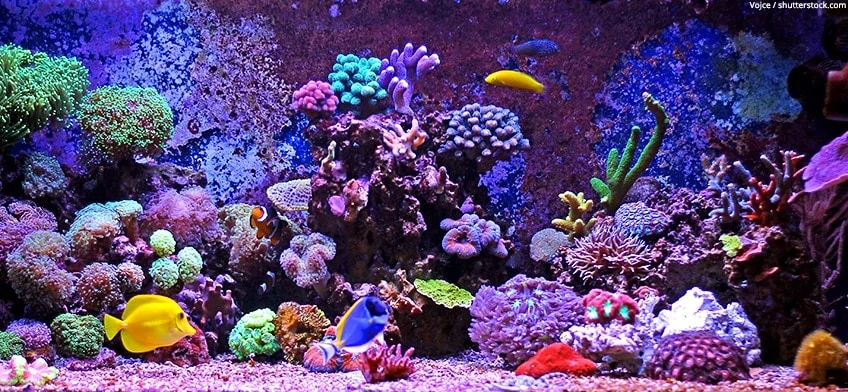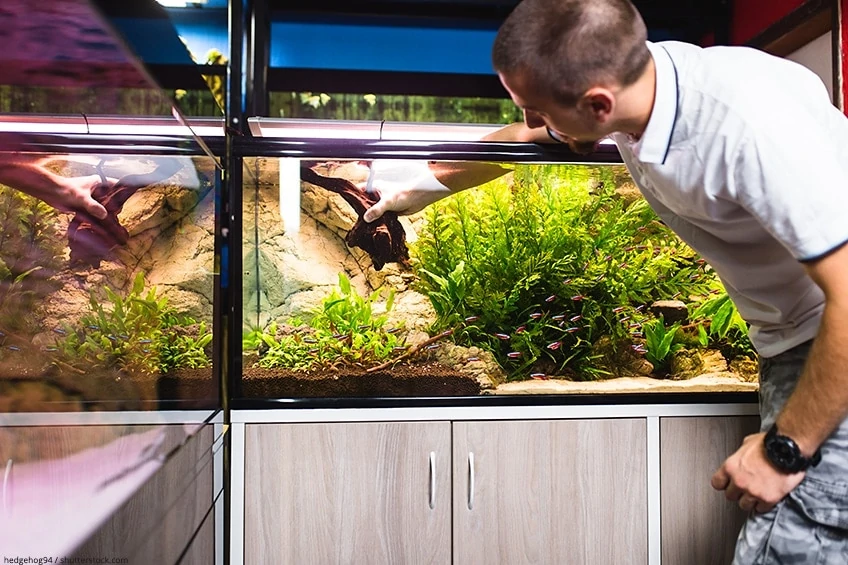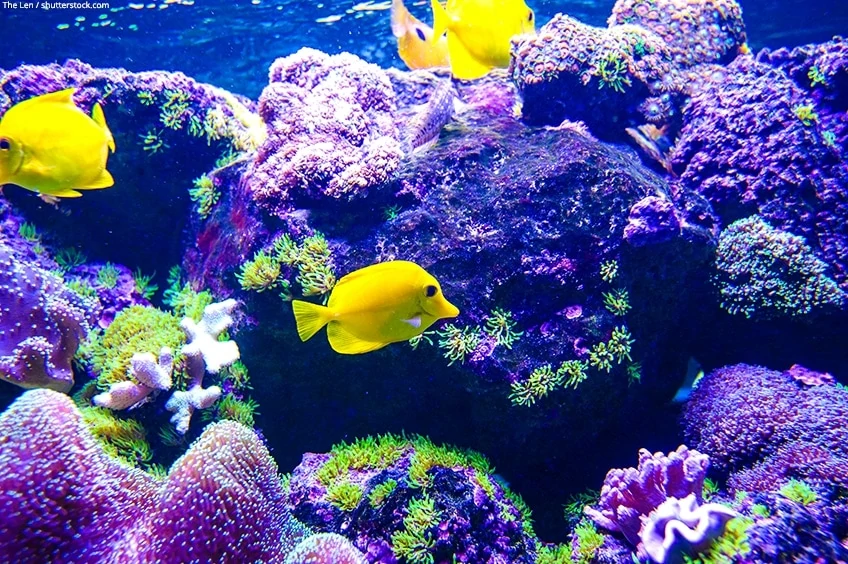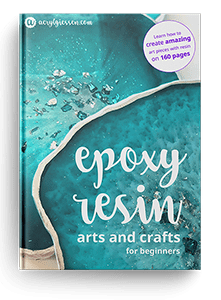Aquarium Safe Epoxy – Learn how to use Resin for your Aquarium
This post may contain affiliate links. We may earn a small commission from purchases made through them, at no additional cost to you. You help to support resin-expert.com
If you would like to do something good for your fish and offer them a little variety, try a landscape made of polystyrene and epoxy resin in the aquarium. With a little skill and the right epoxy resin for your aquarium, you can turn your ideas into reality in no time at all and even protect the underwater world from signs of wear and tear. How this works and what you need to consider when using epoxy resin in aquariums is explained in our guide.
Table of Contents
Applications of epoxy resin in the aquarium
Epoxy resin not only plays a representative role in the aquarium by being used for the creation of impressive landscapes. It can do much more:
- Epoxy resin in the aquarium effectively seals all surfaces and makes them waterproof
- With a combination of polystyrene and epoxy resin, you can create not only varied landscapes for the aquatic life in the aquarium, but also small caves and rock formations as refuges on the back wall
- Epoxy can also be used to glue different parts together
- Even shiny waterfalls can be modelled with it
- You can also make complete surfaces very interesting by sprinkling coarse sand, gravel or quartz stones onto the still wet epoxy resin.
Advantages of sealing with epoxy resin in aquarium construction
- The health of your fish and other aquarium inhabitants should be protected. Sometimes dangerous bacteria nest in the water and endanger the fish population. Then the aquarium must be cleaned laboriously. However, epoxy resin protects the sealed surfaces from potential pathogens. It massively improves the water quality by keeping harmful influences away.
- Even the moisture that would normally attack the design elements after some time can be effectively combated in the aquarium by sealing with epoxy resin. Used correctly, epoxy protects all surfaces from the cool wet.
- Moss has no chance against epoxy in the aquarium – it keeps all surfaces sealed with it free of unwanted plants. This is a great advantage for the owner of the aquarium, as he does not have to clean it extensively.
- Another advantage is the high UV resistance of the epoxy resin. Especially if your aquarium is located in a particularly light-flooded room, it is an advantage to protect the surfaces with a suitable agent. This can be epoxy, as it keeps harmful UV rays away from the sealed surfaces.
- Furthermore, epoxy is not only scratch-resistant, but also impact-resistant and resistant to all animal excrements and is therefore ideally suited to withstand high loads. The surface of the hardened epoxy resin is completely smooth and can therefore be easily disinfected or cleaned if necessary.
- The last big advantage is the compatibility with various additives such as fillers and colorants, because with the help of these you can create the most diverse landscapes the way the user wants them. Whether you want to form a smooth or a seemingly moss-covered rock face, dark stones or light chalk cliffs or maybe even one or the other statue – everything is possible with the right epoxy resin for the aquarium, some styrofoam and a skilful hand.
Suitable epoxy resin
Special terrarium resins are offered, which are perfectly suited for sealing surfaces. They are also a good choice for the aquarium.
Nevertheless, they are much more expensive than the common laminating resins. However, they are completely sufficient for sealing in the aquarium, because cured they not only have all the positive properties of a terrarium resin, but are also non-toxic. They do not emit any harmful substances that could harm aquatic life in any way.
You can therefore easily use a commercially available laminating resin, which can be applied with a brush:
- Crystal clear finish, good for all kinds of DIY projects
- Bubble Free Clear Resin
- Non-toxic, low odor, and high yellowing resistance
These materials in the aquarium can be sealed
In principle, epoxy is suitable for all conceivable materials. However, the user can benefit from epoxy resin on polystyrene when building an aquarium. Styrofoam can be easily modelled, coloured and then sealed with epoxy resin. The epoxy resin does not attack the styrofoam and it keeps its shape.
But other materials can also be sealed with epoxy resin. For example, the resin is also ideal for sealing wood. In this case, however, you should pay attention to the consistency of the epoxy used, as it is available in both thin and thick-bodied versions. Your choice depends on the material to be sealed. If this is porous, an epoxy system with a high penetration force should be chosen. Medium and high viscosity epoxy resin systems, on the other hand, are particularly suitable for smooth surfaces.
Apart from that, epoxy is in principle an all-rounder, which unfolds its positive properties on almost all materials.
Instructions for the sealing of objects in the aquarium
Sealing objects with epoxy resin for the aquarium is not witchcraft. Even if you are a rather inexperienced craftsman, you will succeed with our step-by-step instructions.
Mixing Epoxy Resin
First you have to mix the epoxy resin according to the package insert. Make sure that the correct mixing ratio of resin and hardener is used. If this is not observed, the curing may be insufficient. The resin will remain sticky and cannot develop its positive properties; in addition, harmful substances may be released. Epoxy is only harmless when fully cured.
Put the resin and hardener in a large container and stir thoroughly. If necessary, you can repot the mixture and stir again to make a particularly thorough mixture. Remember to brush along the edge and bottom of the container several times to ensure that the two components are perfectly mixed.
After mixing, the so-called pot life begins. Now you should work quickly, because this is limited. Afterwards the epoxy resin is hardened and cannot be processed further. In case of doubt you should always mix only a little epoxy and later, if necessary, more of it. The cooler the room in which you work, the longer the pot life.
Applyng by Brush
Now apply the epoxy resin with a brush to the surfaces to be treated. These can be different rock formations or objects for the aquarium, but also flat structures or a back wall. These were previously modeled from polystyrene and coated with tile adhesive to create lifelike landscapes or objects.
When sealing with epoxy resin, make sure to apply a thin layer to avoid unsightly lumps on the surface. However, each area should be thoroughly coated with the resin to ensure that the sealant is applied correctly. This is followed by the curing phase.
Observe curing time
Once the epoxy resin is fully cured, it no longer releases any harmful substances. However, the difference between the drying phase and the curing phase is important. The latter takes considerably longer. Only when this has been observed should the surfaces sealed with epoxy resin be used in an aquarium. It is best to follow the manufacturer’s instructions.
Please note that the curing time can vary considerably depending on the ambient temperature and humidity. If in doubt, it is better to give the epoxy resin a little more time – the health of your fish will thank you.
Safety instructions for working with epoxy resin
When working with epoxy resin, disposable gloves as well as a breathing mask and, if necessary, safety goggles must be worn. Ensure that the workplace is adequately ventilated or work outdoors. Long-sleeved clothing is also recommended. Open fire is to be avoided at all costs!
Should the resin come into contact with your skin, wash it off immediately and thoroughly with warm water. In case of contact with your mucous membranes or your eyes, consult a doctor immediately! Take the package insert with you so that he can get an idea of the ingredients.
The design of an aquarium is not only suitable for professionals, but also for untrained craftsmen who simply enjoy modelling. Your aquatic inhabitants will certainly enjoy their new landscape with epoxy resin on styrofoam.







Would it be safe for the fish if I put a small Statue of Liberty polyresin statue in the tank? I don’t know if something like that leaks toxins or not. What would you advise?
Polyresin is often used for aquarium decorations, as it is generally inert and safe for fish tanks. However, it’s crucial to ensure that the specific statue you have does not have any toxic coatings or paint. Some decorative items not specifically made for aquariums might have paints or finishes that can leach harmful chemicals into the water.
If you’re uncertain about the safety of the statue, you can coat it with aquarium-safe epoxy. This creates a barrier that prevents any potential toxins from leaching into the water. Ensure the epoxy is specifically labeled as safe for aquarium use.
I have some stone coat heat resistant resin which is designed for bench tops. Would that be suitable if I made sure to observe the 30 day cure time? I can send you a photo of the product if it helps.
Using a stone coat heat-resistant resin for bench tops could indeed be suitable for your project, especially if it’s specifically designed for such surfaces. These types of epoxy resins are formulated to withstand higher temperatures and are often used in environments where heat resistance is crucial, such as kitchens.
Observing the 30-day cure time is very important. During this period, the resin fully hardens and achieves its maximum durability and heat resistance. Make sure to follow the product’s instructions closely regarding mixing ratios, application, and environmental conditions during the curing process to ensure the best results.
While a photo of the product might provide some additional details, the key factors to consider are the product’s specifications regarding heat resistance, its application instructions, and whether it meets your project’s requirements. If the resin is designed for bench tops and specifies that it can handle the type of usage you have in mind, it should be suitable.
Additionally, consider any other factors that might affect the resin’s performance, such as exposure to UV light, potential for scratching, and compatibility with the materials you’re working with. If your project involves direct contact with food, also ensure the resin is food safe once cured.
Sorry I meant to ask, would a bench-top resin be suitable for sealing driftwood for an aquarium?
Using a bench-top epoxy resin to seal driftwood for an aquarium is a viable option, provided you select the right type of resin. It’s essential to use an epoxy resin that is specifically labeled as safe for use in aquariums, as it needs to be non-toxic and water-resistant once fully cured to ensure it doesn’t harm the aquatic life.
You can find more information in our separate blog post aquarium safe epoxy resin